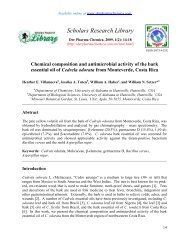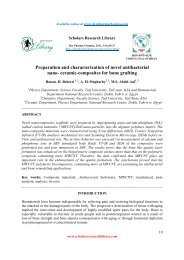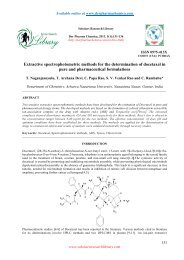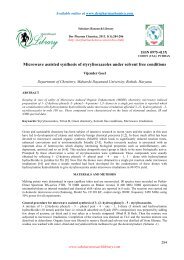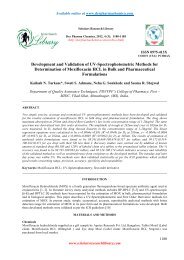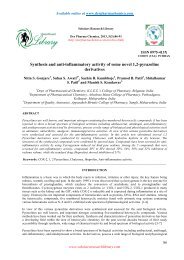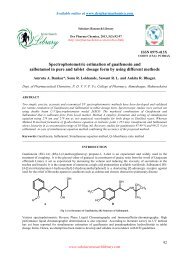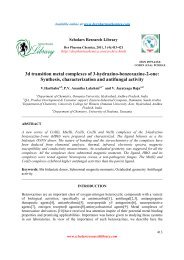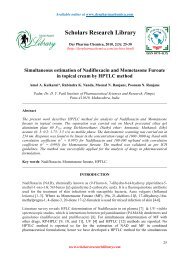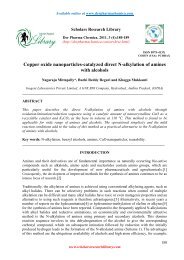Synthesis and evaluation of some novel thiomers as mucoadhesive ...
Synthesis and evaluation of some novel thiomers as mucoadhesive ...
Synthesis and evaluation of some novel thiomers as mucoadhesive ...
Create successful ePaper yourself
Turn your PDF publications into a flip-book with our unique Google optimized e-Paper software.
Rajesh J. Oswal et al Der Pharma Chemica, 2012, 4 (4):1385-1396<br />
_____________________________________________________________________________<br />
neutral <strong>as</strong> possible. A combined gl<strong>as</strong>s electrode w<strong>as</strong> used for this purpose. The tablet w<strong>as</strong> allowed to swell by<br />
keeping it in contact with <strong>of</strong> distilled water in petri plate for 2 hours at room temperature. The P H w<strong>as</strong> identified by<br />
bringing the electrode into contact with the tablet surface <strong>and</strong> allowing the surface to equilibrate for 1 minute [21].<br />
Evaluation <strong>of</strong> the swelling behavior<br />
The swelling properties <strong>and</strong> the erosion characteristics <strong>of</strong> tablets were evaluated by determination <strong>of</strong> % <strong>of</strong><br />
Hydration. Each tablet w<strong>as</strong> weighed (W1) <strong>and</strong> immersed in distilled water for predetermined times (4 hr) [22]. After<br />
immersion, tablets were wiped <strong>of</strong>f by the excess <strong>of</strong> surface water by the use <strong>of</strong> filter paper <strong>and</strong> weighed (W2).The<br />
swelling index w<strong>as</strong> calculated by using formula,<br />
Swelling index = W2 - W1 × 100<br />
W1<br />
Determination <strong>of</strong> ex-vivo Mucoadhesive strength<br />
A modified balance method w<strong>as</strong> used for determining the ex vivo <strong>mucoadhesive</strong> strength. Fresh sheep intestinal<br />
mucosa w<strong>as</strong> obtained from a local slaughterhouse <strong>and</strong> used within 2 hours <strong>of</strong> slaughter. The mucosal membrane w<strong>as</strong><br />
separated by removing the underlying fat <strong>and</strong> loose tissues. The membrane w<strong>as</strong> w<strong>as</strong>hed with distilled water <strong>and</strong> then<br />
with phosphate buffer P H 6.8. The fresh sheep intestinal mucosa w<strong>as</strong> cut into pieces <strong>and</strong> w<strong>as</strong>hed with phosphate<br />
buffer P H 6.8. A piece <strong>of</strong> intestinal mucosa w<strong>as</strong> tied to the open mouth <strong>of</strong> a gl<strong>as</strong>s vial, which w<strong>as</strong> filled completely<br />
with phosphate buffer P H 6.8, <strong>and</strong> held on the left side <strong>of</strong> the balance. The gl<strong>as</strong>s vial with rubber stopper w<strong>as</strong> placed<br />
<strong>and</strong> tightly fitted in the center <strong>of</strong> gl<strong>as</strong>s beaker containing phosphate buffer ( P H 6.8, 37°C ± 1°C) just touching the<br />
mucosal surface. The tablet w<strong>as</strong> stuck to the lower side <strong>of</strong> the rubber stopper <strong>of</strong> the gl<strong>as</strong>s vial by applying <strong>some</strong><br />
force through fingertip for five minutes. The left <strong>and</strong> right pans were balanced by adding a 5g weight on the right<br />
h<strong>and</strong> pan. When the 5-g weight w<strong>as</strong> removed from the right-h<strong>and</strong> pan, the left-h<strong>and</strong> pan along with the tablet w<strong>as</strong><br />
lowered over the mucosa. The balance w<strong>as</strong> kept in this position for 5 minutes. Water w<strong>as</strong> added slowly at 100<br />
drops/min to the right-h<strong>and</strong> pan until the patch detached from the mucosal surface. The weight (gram force) required<br />
to detach the tablet from the mucosal surface gave the me<strong>as</strong>ure <strong>of</strong> <strong>mucoadhesive</strong> strength [21, 23].<br />
Determination <strong>of</strong> ex-vivo Mucoadhesion Time<br />
The ex vivo mucoadhesion time w<strong>as</strong> performed after application <strong>of</strong> the Mucoadhesive tablet on freshly cut sheep<br />
intestinal mucosa. The fresh sheep intestinal mucosa w<strong>as</strong> tied on the gl<strong>as</strong>s slide <strong>and</strong> a <strong>mucoadhesive</strong> core side <strong>of</strong><br />
each tablet w<strong>as</strong> wetted with 1 drop <strong>of</strong> phosphate buffer P H 6.8 <strong>and</strong> p<strong>as</strong>ted to the sheep intestinal mucosa by applying<br />
a light force with a fingertip for 30 sec. The gl<strong>as</strong>s slide w<strong>as</strong> then put in the beaker, which w<strong>as</strong> filled with 200 ml <strong>of</strong><br />
the phosphate buffer P H 6.8 <strong>and</strong> w<strong>as</strong> kept at 37 ± 1°C. After 2 min, a 50 rpm stirring rate w<strong>as</strong> applied to simulate the<br />
intestinal cavity environment <strong>and</strong> tablet adhesion w<strong>as</strong> monitored for 6 hrs. The time for the tablet to detach from the<br />
sheep intestinal mucosa w<strong>as</strong> recorded <strong>as</strong> the mucoadhesion time [24-26].<br />
In Vitro Drug Rele<strong>as</strong>e<br />
The USP XXIII dissolution apparatus 2 (Veego scientific, Mumbai, India) w<strong>as</strong> used to study the drug rele<strong>as</strong>e from<br />
the <strong>mucoadhesive</strong> tablet. The dissolution medium consisted <strong>of</strong> 900 mL <strong>of</strong> 0.1N Hydrochloric Acid. The rele<strong>as</strong>e<br />
study w<strong>as</strong> performed at 37°C ± 0.5°C, for 2 hrs. with a rotation speed <strong>of</strong> 50 rpm. Then the dissolution medium w<strong>as</strong><br />
replaced with phosphate buffer P H 6.8 <strong>and</strong> rele<strong>as</strong>e study performed for additional 4 hrs. Samples <strong>of</strong> 5 mL were<br />
withdrawn at predetermined time intervals <strong>and</strong> replaced with fresh medium. The samples were filtered through 0.2-<br />
µm Whatman filter paper <strong>and</strong> analyzed after appropriate dilution by UV spectrophotometer (Double beam<br />
spectrophotometer 2203, Systronics) at 233 nm. % cumulative drug rele<strong>as</strong>e (%CDR) in 6 hours w<strong>as</strong> calculated from<br />
the UV absorbance values <strong>of</strong> each aliquot. A plot <strong>of</strong> time versus % CDR w<strong>as</strong> studied to determine the drug rele<strong>as</strong>e<br />
pattern for each batch <strong>of</strong> tablet [21,26].<br />
RESULTS AND DISCUSSION<br />
<strong>Synthesis</strong> <strong>of</strong> thiolated polymers<br />
The thiolated polymers <strong>of</strong> starch <strong>and</strong> gaur gum namely, CMS-C, CMG-C, respectively were synthesised <strong>as</strong> per the<br />
scheme <strong>of</strong> synthesis. The intermediate carboxymethyl starch (CMS) <strong>and</strong> carboxymethyl gaur gum (CMG) were<br />
synthesised by reacting starch/gaur gum with monochloroacetic acid. The first step is an alkalization where the<br />
hydroxyl groups <strong>of</strong> the starch molecules are activated <strong>and</strong> changed into the more reactive alkoxide form (St–O-) /<br />
(GG-O-). This is followed by etherification in the second step by using monochloroacetic acid.<br />
1388<br />
www.scholarsresearchlibrary.com



